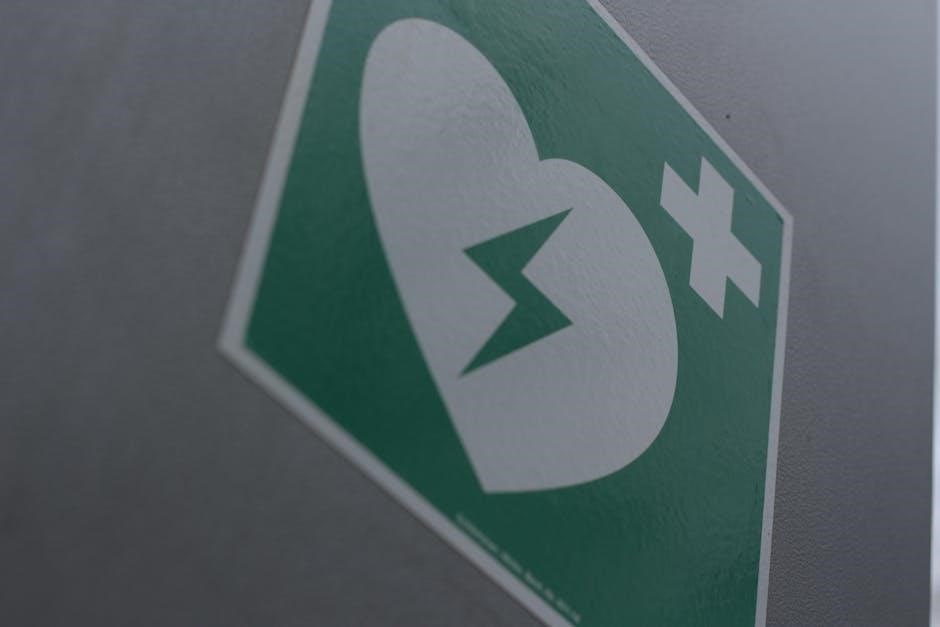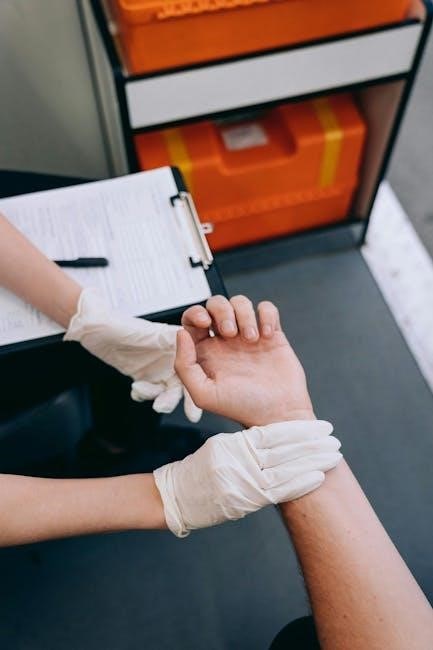
first aid usmle step 1 pdf
The USMLE Step 1 is a critical exam for medical students, assessing foundational knowledge in sciences like anatomy, biochemistry, and physiology. It is the first step toward medical licensure in the United States, requiring rigorous preparation and strategic study resources, such as the First Aid guide, to ensure success.
1.1. Overview of the USMLE Step 1 Exam
The USMLE Step 1 is a foundational assessment for medical students, evaluating knowledge in sciences like anatomy, biochemistry, and physiology. It is a multiple-choice exam administered over eight hours, with 280 questions. The exam is computer-based and scored numerically, with a passing score required for progression. It is a critical milestone for residency placement and licensure in the U.S., necessitating strategic preparation and resources like First Aid for USMLE Step 1 to master high-yield topics efficiently.
1.2. Importance of Preparation for USMLE Step 1
Preparation for the USMLE Step 1 is crucial for achieving a high score, which significantly impacts residency opportunities. The exam evaluates foundational medical knowledge, making thorough study essential. Students must allocate substantial time to review high-yield topics and practice with question banks. Inadequate preparation can lead to poor performance, affecting future career prospects. Utilizing resources like First Aid for the USMLE Step 1 ensures focused study, covering essential concepts and clinical correlations necessary for success. Consistent and strategic preparation is key to excelling in this high-stakes exam.

First Aid for the USMLE Step 1: An Overview
First Aid for the USMLE Step 1 is a widely used study guide for medical students, offering concise, high-yield content. Its annual updates ensure relevance, and the PDF format makes it accessible for efficient preparation, covering essential topics for exam success.
2.1. What is First Aid for the USMLE Step 1?
First Aid for the USMLE Step 1 is a renowned, student-to-student guide designed to simplify and streamline preparation for the exam. It provides concise, high-yield information covering essential topics like pharmacology, pathology, and physiology. Organized into sections such as “Guide to Efficient Exam Preparation” and “High-Yield General Principles,” the guide ensures focused learning. Updated annually, it reflects the latest exam trends and content. The PDF format enhances accessibility, making it a indispensable resource for medical students aiming to excel on the USMLE Step 1.
2.2. Evolution of the First Aid Book
First Aid for the USMLE Step 1 has evolved significantly since its inception, adapting to changing exam content and student needs. Early editions focused on basic high-yield facts, while recent versions incorporate clinical correlations and mnemonics. The 2024 edition introduced enhanced sections on pharmacology and pathology, reflecting exam trends. The shift to digital formats, including the popular PDF version, has made it more accessible, ensuring students can study efficiently. This evolution underscores its commitment to helping students achieve success on the USMLE Step 1.
2.3. Key Features of the First Aid USMLE Step 1 PDF
The First Aid USMLE Step 1 PDF is renowned for its concise, high-yield content tailored to exam success. It includes detailed sections on pharmacology, pathology, and physiology, with clinical correlations to bridge theory and practice. The 2024 edition spans 740-746 pages, offering a comprehensive yet focused approach. Digital accessibility allows easy navigation and annotation, making it a preferred resource for efficient studying. Regular updates ensure alignment with the latest exam trends, enhancing its relevance for aspiring physicians preparing for the USMLE Step 1.

Content Organization in First Aid USMLE Step 1
First Aid USMLE Step 1 is organized into four main sections: Guide to Efficient Exam Preparation, High-Yield General Principles, Organ Systems, and Special Situations, ensuring comprehensive coverage.
3.1. Section I: Guide to Efficient Exam Preparation
Section I of First Aid USMLE Step 1 provides a roadmap for effective exam preparation. It covers strategies for defining study goals, creating schedules, and understanding exam format. This section emphasizes time management and high-yield topics, ensuring students focus on key areas. Additionally, it offers tips for staying motivated and maintaining well-being during the rigorous study period. The guide is tailored to help learners maximize their efficiency and confidence as they approach the exam.
3.2. Section II: High-Yield General Principles
Section II focuses on foundational concepts critical for success on the USMLE Step 1. It covers essential topics such as cellular and molecular biology, genetics, and immunology, providing a solid base for understanding complex medical principles. This section is designed to reinforce key theories and mechanisms, ensuring a strong grasp of the material. By mastering these high-yield principles, students build a robust foundation necessary for tackling the exam’s challenging questions.
3.3. Section III: Organ Systems
Section III delves into the core organ systems, offering detailed insights into their structure, function, and pathophysiology. It covers high-yield topics such as the cardiovascular, respiratory, gastrointestinal, and renal systems, among others. Each chapter emphasizes key diseases, clinical correlations, and pharmacological interventions. The section also includes mnemonics and charts to aid in memorization. By linking basic sciences to clinical practice, this part of First Aid equips students with the knowledge needed to excel on the USMLE Step 1, focusing on both comprehension and application of critical concepts.
3.4. Section IV: Special Situations
Section IV addresses unique clinical scenarios and exceptional cases that demand a tailored approach. It covers critical care medicine, emergency situations, and ethical dilemmas, providing high-yield information on managing complex patients. This section also includes algorithms, mnemonics, and radiographic findings to enhance problem-solving skills. By focusing on these special situations, First Aid helps students navigate high-pressure scenarios confidently, ensuring they are well-prepared for the USMLE Step 1 and real-world clinical challenges.

High-Yield Topics in First Aid USMLE Step 1
High-yield topics include pharmacology, pathology, physiology, biochemistry, and microbiology, focusing on key concepts and clinical correlations essential for USMLE Step 1 success.
4.1. Pharmacology
Pharmacology is a high-yield topic in First Aid, focusing on drug mechanisms, side effects, and clinical uses. It emphasizes key classes like antibiotics, antihypertensives, and antineoplastics. The guide provides concise, memorable details on pharmacokinetics and pharmacodynamics, linking drugs to their targets and diseases. Mnemonics and tables help organize complex information, ensuring mastery of essential concepts for USMLE Step 1. Regular updates reflect the latest advancements in pharmacotherapy, making it a reliable resource for exam preparation.
4.2. Pathology
Pathology in First Aid USMLE Step 1 focuses on high-yield diseases, emphasizing their causes, symptoms, and histopathological features. The guide covers key organ systems, such as cardiovascular, respiratory, and gastrointestinal, highlighting common pathologies. It includes mnemonics and clinical correlations to aid memorization. Topics like inflammation, neoplasia, and infectious diseases are thoroughly addressed, with a focus on USMLE-relevant content. The section is designed to help students quickly grasp critical pathological concepts, ensuring they are well-prepared for exam questions.
4.3. Physiology
Physiology in First Aid USMLE Step 1 is tailored to highlight high-yield concepts essential for the exam. It focuses on core systems like cardiovascular, respiratory, and renal physiology, presenting content in a concise and organized manner. The guide uses charts, tables, and mnemonics to simplify complex processes, making them easier to retain. Key topics include blood gas interpretation, acid-base balance, and neurophysiology. Clinical correlations are integrated to help students connect basic science with real-world applications, ensuring a strong foundation for exam success.
4.4. Biochemistry
Biochemistry in First Aid USMLE Step 1 emphasizes high-yield topics like metabolic pathways, enzyme kinetics, and molecular biology. The guide simplifies complex processes with clear diagrams and tables, focusing on areas frequently tested on the exam. Key sections include glycolysis, the citric acid cycle, and lipid metabolism, along with clinically relevant topics such as metabolic disorders. Mnemonics and memory aids are incorporated to enhance retention, ensuring students grasp essential concepts efficiently and effectively for exam success.
4.5. Microbiology and Immunology
Microbiology and Immunology in First Aid USMLE Step 1 are presented with a focus on high-yield pathogens, their mechanisms, and clinical correlations. The guide simplifies complex immune responses, vaccine types, and infectious diseases. Key topics include bacterial physiology, viral replication, fungal infections, and immunodeficiency disorders. Detailed tables and mnemonics help students master difficult concepts, such as antibiotic resistance and cytokine functions. This section ensures a strong foundation for understanding both the basic science and its clinical applications, crucial for success on the exam.

Study Strategies Using First Aid USMLE Step 1
Maximize your preparation with active recall, spaced repetition, and integrating First Aid with resources like UWorld, Anki flashcards, and Pathoma for a comprehensive study approach.
5.1. Active Recall and Spaced Repetition
Active recall involves actively remembering information rather than passively reading it, enhancing retention and understanding. Spaced repetition ensures revisiting material over time, preventing forgetting. Both strategies are crucial for mastering high-yield topics in First Aid for the USMLE Step 1. Use flashcards or Anki to apply these methods, focusing on weak areas and reinforcing key concepts regularly. This approach optimizes study time, improves long-term retention, and aligns with the exam’s content, making it easier to recall critical information during the test.
5.2. Integrating First Aid with Other Resources
Combining First Aid with other study materials enhances comprehension and retention. Use UWorld for question practice, Pathoma for pathology visuals, and Anki for flashcards to reinforce concepts. Cross-referencing these tools ensures a well-rounded understanding. First Aid provides the framework, while supplementary resources fill knowledge gaps and refine test-taking skills. This integrated approach maximizes study efficiency, ensuring a deeper grasp of high-yield topics and improving performance on the USMLE Step 1.
5.3. Creating a Study Schedule
A well-structured study schedule is essential for USMLE Step 1 success. Allocate specific times for reviewing First Aid, practicing UWorld questions, and reinforcing concepts with Anki flashcards. Ensure your plan balances intense study periods with breaks to avoid burnout. Regularly review and adjust your schedule to stay on track, focusing on high-yield topics and weak areas. Incorporate dedicated time for practice exams and consistent revision of material. A disciplined yet flexible schedule ensures efficient preparation and mastery of the content.
Updates in the Latest Edition of First Aid USMLE Step 1
The 2024 edition includes expanded pharmacology and pathology sections, updated clinical correlations, and new mnemonics. The 2025 edition is anticipated to further refine high-yield content for exam success.
6.1. What’s New in the 2024 Edition
The 2024 edition of First Aid for the USMLE Step 1 introduces enhanced content in pharmacology, pathology, and physiology. It features updated clinical correlations, new mnemonics, and revised illustrations to aid memory retention. Additionally, emerging topics in medical education, such as high-yield microbiology and immunology concepts, have been expanded. The book also incorporates feedback from recent test-takers, ensuring relevance and accuracy. These updates aim to reflect the latest exam trends and provide students with a comprehensive, concise study resource.
6.2. Changes in the 2025 Edition
The 2025 edition of First Aid for the USMLE Step 1 includes expanded coverage of emerging topics in microbiology and immunology, reflecting recent advancements. New high-yield clinical scenarios and updated mnemonics have been added to enhance retention. The book also features improved formatting, with clearer diagrams and tables, making complex concepts more accessible. Additionally, user feedback has led to more detailed explanations in pharmacology and pathology sections. These changes ensure the guide remains aligned with the latest exam trends and student needs.

Supplementary Resources for USMLE Step 1 Preparation
Supplementary resources like UWorld, Anki flashcards, and Pathoma complement First Aid, offering comprehensive practice questions, interactive learning tools, and detailed video lectures to enhance exam preparation strategies.
7.1. UWorld Question Bank
UWorld Question Bank is a highly regarded resource for USMLE Step 1 preparation, offering over 3,000 practice questions that mimic the exam’s difficulty and format. Each question includes detailed explanations, helping students understand core concepts and identify knowledge gaps. Its robust analytics track performance, enabling focused improvement. UWorld’s clinical vignette-style questions emphasize critical thinking and application of basic sciences to clinical scenarios. Regular use of UWorld, alongside First Aid, strengthens problem-solving skills and builds exam confidence, making it an essential tool for achieving high scores.
7.2. Anki Flashcards
Anki Flashcards are a powerful tool for USMLE Step 1 preparation, utilizing spaced repetition to enhance long-term retention. Pre-made decks like Zanki and Lightyear offer comprehensive, high-yield content aligned with First Aid and exam topics. Users can customize cards to focus on weak areas, and the active recall method strengthens memory. Regular review with Anki complements other resources, ensuring efficient mastery of the vast material required for success on the USMLE Step 1.
7.3. Pathoma
Pathoma is a highly regarded resource for USMLE Step 1 preparation, offering detailed video lectures and notes focused on pathology. Taught by Dr. Husain Sattar, it simplifies complex concepts through clear explanations and clinical correlations. The material aligns well with First Aid, making it an excellent supplement for reinforcing high-yield topics. Pathoma’s structured approach and practical examples help students master challenging subjects, while its notes provide a concise review resource. It is particularly valued for its ability to bridge basic science with clinical applications, enhancing overall understanding and exam readiness.

First Aid USMLE Step 1 PDF: Download and Access
The First Aid USMLE Step 1 PDF is a popular resource for exam preparation, available through official sources, with options for free or paid access, ensuring legal use.
8.1. Official Sources for Download
The official sources for downloading the First Aid USMLE Step 1 PDF include the publisher’s website, authorized retailers, and educational platforms. These sources ensure authenticity and legality, providing the most updated editions. Students can access the PDF directly through these channels, often requiring a purchase or subscription. Additionally, some medical schools and libraries offer access to the resource. Always verify the source to avoid unauthorized or outdated versions, ensuring compliance with copyright laws and optimal study material quality.
8.2. Free vs. Paid Versions
While free versions of the First Aid USMLE Step 1 PDF may be available online, they often lack critical updates or may be outdated. Paid versions, purchased through official channels, provide the latest editions, ensuring access to the most current and comprehensive material. Free downloads may also pose legal and quality risks, as they are often unauthorized copies. Investing in the paid version guarantees high-quality content, supporting the creators and ensuring adherence to copyright laws, which is essential for optimal preparation and exam success.
8.3. Legal Considerations
Accessing the First Aid USMLE Step 1 PDF legally is crucial to avoid copyright infringement. Purchasing from official sources like McGraw-Hill ensures compliance with laws and supports content creators. Downloading unauthorized copies risks legal consequences and undermines the quality of materials. Users with print disabilities should use authorized platforms to access adapted versions legally. Always prioritize official channels to stay compliant and ethical in your preparation journey.

Common Mistakes to Avoid in USMLE Step 1 Prep
Overreliance on a single resource, neglecting practice exams, and inconsistent study habits are common pitfalls. Ensure a balanced approach to maximize your preparation effectiveness with First Aid and other tools.
9.1. Overloading with Too Many Resources
Overloading with too many study resources is a common mistake, leading to confusion and decreased productivity. While the First Aid USMLE Step 1 PDF is a cornerstone, relying on excessive materials can dilute focus. Many students collect numerous notes and guides, only to find it overwhelming. Instead, prioritize a few high-yield resources, such as First Aid, UWorld, and Pathoma, and integrate them strategically. Avoid the temptation to chase every new resource; consistency and depth in study are more effective than breadth. Stick to a well-structured plan to maximize efficiency and retention.
9.2. Neglecting Practice Exams
Neglecting practice exams is a significant mistake in USMLE Step 1 preparation. Practice exams are essential for assessing knowledge, identifying weak areas, and acclimating to the exam format. Without them, students may struggle with time management and question types. Regular practice helps improve test-taking strategies and reduces anxiety. It’s crucial to incorporate practice exams, such as those from UWorld or First Aid, into your study routine to ensure readiness for the actual test day effectively.
9.3. Inconsistent Study Habits
Inconsistent study habits are a common pitfall in USMLE Step 1 preparation. Irregular study sessions lead to poor retention of high-yield topics and inadequate mastery of key concepts. Without a structured routine, students often fall behind, making it difficult to cover the vast syllabus effectively. Regular, focused study sessions are essential for steady progress and long-term retention of the material covered in resources like First Aid for the USMLE Step 1. Maintaining consistency ensures a strong foundation for exam success and reduces last-minute cramming stress.

The Role of First Aid in USMLE Step 1 Success
First Aid for the USMLE Step 1 is a high-yield resource that condenses essential exam material, making it indispensable for focused preparation and achieving success on the exam.
10.1. High-Yield Facts and Concepts
First Aid for the USMLE Step 1 excels in delivering high-yield facts and concepts, focusing on the most frequently tested topics. It organizes information into concise, bullet-point sections, making it easier to review and retain critical details. The guide emphasizes key areas like pharmacology, pathology, and physiology, ensuring students master the essentials. By prioritizing high-yield material, First Aid helps candidates allocate study time efficiently, maximizing their score potential on the exam.
10.2. Clinical Correlations
First Aid for the USMLE Step 1 strengthens understanding by linking basic sciences to clinical scenarios. This approach helps students grasp how theoretical concepts apply to real patient cases, a critical skill for the exam. By focusing on clinically relevant material, the guide enhances the ability to think critically and make connections between diseases, symptoms, and treatments. This feature is particularly valuable for high-yield topics, ensuring students can apply knowledge effectively in both exam and clinical settings.
10;3. Mnemonics and Memory Aids
First Aid for the USMLE Step 1 incorporates mnemonics and memory aids to simplify complex concepts, making them easier to retain. These tools help students remember key facts, such as drug mechanisms, disease associations, and physiological pathways. By leveraging mnemonics, learners can reduce study time and improve retention, particularly for high-yield topics like pharmacology and pathology. The latest editions of the guide emphasize these aids, ensuring students can recall critical information efficiently during the high-pressure exam environment.

Final Tips for Mastering First Aid USMLE Step 1
Regularly review high-yield topics, practice with flashcards, and focus on weak areas. Stay organized, use mnemonics, and integrate First Aid with other resources for comprehensive preparation.
11.1. Focus on Weak Areas
Identify and prioritize weak areas using the First Aid USMLE Step 1 PDF. Review high-yield topics and practice questions to strengthen knowledge gaps. Use flashcards and mnemonics to reinforce difficult concepts. Regularly assess progress through self-tests and adjust study plans accordingly. Consistency and targeted focus on weak subjects ensure comprehensive mastery of the material, boosting overall performance on the exam.
11.2. Practice with Flashcards
Utilize flashcards to reinforce high-yield facts from the First Aid USMLE Step 1 PDF. Create cards for key terms, concepts, and clinical correlations. Review them regularly to enhance retention and active recall. Tools like Anki integrate seamlessly with First Aid content, allowing for efficient spaced repetition. Flashcards are particularly effective for memorizing pharmacology, pathology, and physiology details. Consistent use helps build a strong foundation, ensuring readiness for the exam’s challenging questions.
11.3. Review and Revisit Material
Regularly reviewing and revisiting material from the First Aid USMLE Step 1 PDF is essential for long-term retention. Focus on high-yield topics and clinical correlations to reinforce understanding. Use active recall techniques to test knowledge gaps. Revisiting sections periodically ensures mastery of complex concepts like pharmacology and pathology. Combine this with practice exams to assess readiness. This iterative process helps identify weak areas and solidifies foundational knowledge, making it a cornerstone of successful USMLE Step 1 preparation.
The First Aid USMLE Step 1 PDF is a cornerstone resource for exam success, offering high-yield content and strategic insights. Dedication and consistent effort will ensure mastery.
12.1. Final Thoughts on First Aid USMLE Step 1
First Aid USMLE Step 1 is an indispensable resource, providing concise, high-yield information essential for exam success. Its structured approach and clinical correlations make it a trusted guide for medical students. By focusing on key topics and integrating active learning strategies, students can maximize their preparation. Regular updates ensure relevance, while the PDF format offers accessibility. Utilizing First Aid effectively is crucial for achieving a strong score on the USMLE Step 1.
12.2. Encouragement for Future Success
Embrace the journey of USMLE Step 1 preparation with confidence and perseverance. Leverage resources like First Aid and supplementary materials to strengthen your knowledge; Stay consistent, focus on weak areas, and practice with flashcards for retention. Remember, success is a result of dedicated effort and strategic learning. Trust in your abilities and the tools available to guide you. Your hard work will pave the way for a rewarding medical career. Keep pushing forward and aim for excellence in your studies and beyond.

Leave a Reply
You must be logged in to post a comment.